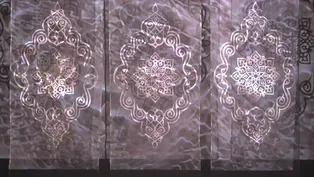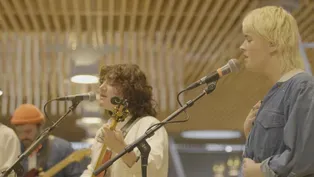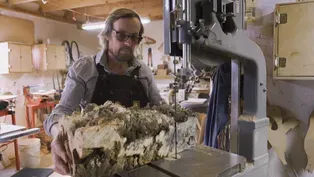Oregon Art Beat
Amirra Malak, Uli Kirchler, The Apricots
Season 26 Episode 5 | 24m 54sVideo has Closed Captions
Fiber artist Amirra Malak, woodworker Uli Kirchler, music by The Apricots
Amirra Malak is an Egyptian American artist living in Oregon while also inhabiting liminal spaces between cultures, countries and identities. She feels most at home in liminal spaces, using light, pattern, movement, time, and sound to create meditative, healing experiences. Discover how Oregon artist Uli Kirchler transforms gnarly burl wood into telescoping castles. Oregon band The Apricots plays.
Problems with Closed Captions? Closed Captioning Feedback
Problems with Closed Captions? Closed Captioning Feedback
Oregon Art Beat is a local public television program presented by OPB
Oregon Art Beat
Amirra Malak, Uli Kirchler, The Apricots
Season 26 Episode 5 | 24m 54sVideo has Closed Captions
Amirra Malak is an Egyptian American artist living in Oregon while also inhabiting liminal spaces between cultures, countries and identities. She feels most at home in liminal spaces, using light, pattern, movement, time, and sound to create meditative, healing experiences. Discover how Oregon artist Uli Kirchler transforms gnarly burl wood into telescoping castles. Oregon band The Apricots plays.
Problems with Closed Captions? Closed Captioning Feedback
How to Watch Oregon Art Beat
Oregon Art Beat is available to stream on pbs.org and the free PBS App, available on iPhone, Apple TV, Android TV, Android smartphones, Amazon Fire TV, Amazon Fire Tablet, Roku, Samsung Smart TV, and Vizio.
Providing Support for PBS.org
Learn Moreabout PBS online sponsorshipSupport for Oregon Art Beat is provided by Jordan Schnitzer and the Harold & Arlene Schnitzer Care Foundation Endowed Fund for Excellence... and OPB members and viewers like you.
Funding for arts and culture coverage is provided by... [ ♪♪♪ ] [ bird caws ] [ ♪♪♪ ] AMIRRA: For me, liminal space is the space between.
Liminal space is not solid.
I'm trying to get that feeling of in-between shimmering light and pattern.
I'm interested in the space between objects more than the object itself.
[ ♪♪♪ ] My name is Amirra Malak.
I'm half Egyptian, half American.
I'm also a twin.
I feel like I've always existed in, like, the space between.
The space between binaries is actually, to me, really sacred.
There's been sort of a thread through my work from painting till now, and that has been, like, wanting to communicate sacredness.
One of the places that I've experienced the sacred the most is in the natural world.
[ ♪♪♪ ] When I was painting, I would do imagery like shimmering trees... shimmering water.
I would embed Arabic text to show sacredness.
Sometimes the word "baraka," which is like "that which is imbued with sacredness," would be written over and over again as a meditation and a pattern over the water.
I've done tree paintings... with Egyptian belly-dancing beat written into it, with... [ imitates rhythmic beat ] ...like over and over again to kind of show that dissolving sound and light and liminal space.
[ ♪♪♪ ] And often I would put khayamiya patterns into my paintings.
Khayamiya is an ancient art form in Egypt.
Very delicate, like hand-stitched appliqué.
[ ♪♪♪ ] Khayamiya was used as tent panels, inside of tent decorations, and then when I was growing up, there were prints of khayamiya hung at, like, weddings and funerals.
So to me they always signify celebration or something sacred.
So I was blessed to be able to finally visit the street of the tent makers in Cairo, one of the oldest covered markets.
Khayamiya has been sewn there for many generations.
[ ♪♪♪ ] I received an Oregon Arts Commission and Ford Foundation grant to be able to study with a master khayamiya artist named Mostafa Ellassy.
Here's Mostafa's store.
He's been sewing khayamiya for 45 years, and he's part of a multigenerational family that has sewn khayamiya.
He's one of the last of seven families that are sewing this at the tent-makers street.
None of their kids are choosing to carry on the tradition.
Oh, both sides.
MOSTAFA: Mm-hmm.
AMIRRA: Before you sew, this and this are tucked, okay.
What about the corner, did you anchor...?
MOSTAFA: The corner, I-- Two on two.
[ overlapping conversation ] [ ♪♪♪ ] AMIRRA: Learning the traditional craft in Egypt and bringing it here is really honoring my true identity.
I feel so connected to the land here from living here so long, and the Columbia River.
But I'm also connected to the Nile River.
I was working on some paintings of water and the sacredness of water.
I would go out and film and photograph water, and I felt like it communicated what I was trying to say more than, like, pushing materials around on a painting.
And then I started playing with, like, projecting the video on just pieces of fabric.
[ ♪♪♪ ] So the fact that video can go on and through was, like, totally my jam.
I take a roll of paper and I put an iron-on adhesive on the back, and then I will draw out the design and then hand-cut every tiny little hole.
It's quite neurotic, but it's really fun.
It's kind of meditative.
And then I'll lay that on transparent silk.
So you've got translucent video happening and then opaque lines on the wall.
[ ♪♪♪ ] Khayamiya is a very slow process even for a master artist.
So it can take six months to make a really large panel.
My mother always sews everything by hand, and so I grew up seeing that.
She would sew me dolls, she would embroider my shirts, and I would see how long it took her.
If you wanted to really honor somebody, you did something slow and by hand.
You know, all of this is not cut to scale yet.
So when you get to a corner, you've got to do two stitches.
This is actually one of the most difficult kinds of turns right here.
And if I can eventually hand-stitch these panels in the traditional khayamiya style, like, it'll be an honoring and an act of love.
[ ♪♪♪ ] "I chose to swim away, assuming I could always return.
But the river has changed and the wall is so tall."
[ ♪♪♪ ] I was so connected to my twin.
After he passed, the first time I ever made one of these panels, I just felt like he was with me in, like, every cut.
When it first went up, I felt like I was honoring his memory.
[ Amirra sighs deeply ] He brought so much beauty to the world.
[ exhales deeply ] And so he's gone, but, like, I can honor him by continuing to make beauty.
[ ♪♪♪ ] My twin is on the other side, so now I'm in the space between life and death.
When you're an installation artist, you're always on the hunt for, like, "Where can I show this?"
Hi, Amirra.
Hello.
Hi.
And so I approached Ryan Huntington, who I knew from a previous event, and asked if I could set up my work.
So it's going to be nine feet wide, about.
Okay, yeah, we should probably be okay.
So this is going to be the... AMIRRA: Okay, so-- Oh, I see, it hooks in.
I'm Ryan Huntington, and I am the general manager and co-owner of The Ruins.
The Ruins is an event space.
We do all kinds of events.
We really focus on community events and art events.
I love how, without any previous knowledge of context, you can walk up to her installations and have a moment.
[ ♪♪♪ ] And get some feels.
And then when you learn the context, it just adds, like, so many layers on top of that.
You know, it's a deep experience.
So for me, sometimes I get so busy creating the work that I forget to experience the work and just-- For example, today I was quite frenetic and, like, trying to get the projector to work.
I'm not even centered at this point.
And it just freaked out.
It was a little stressful, and I was definitely not in this, like, zen liminal space.
And then I walked through the space.
I stood there for a while and really felt it.
[ ♪♪♪ ] I've been regulated by my own work, if that makes sense.
[ ♪♪♪ ] I would love to have an interactive component with people's heartbeats and to have the video itself, like, pulse with the viewer.
And I call it "Altared Space," like A-L-T-A-R.
So creating an altar for people to step into and have a sacred experience.
Visual stimulation is a spiritual experience, and I want to share that feeling with people.
[ harmonica, guitar, and drum playing folk tune ] ULI: Without a window, there's no life.
It feels so magical once I cut these windows out.
It feels like I give the piece life.
[ ♪♪♪ ] Collaborating with nature is part of my job.
Respecting what nature gave me already.
I just try to bring the best out of it.
Its kind of showtime for me when I get to peel off the bark and see what it truly looks like on the inside.
And these natural bumps, I mean, this is going to be a beautiful piece.
Let's see.
There's a few little bugs here.
Sometimes bugs are really beautiful because they leave nice channels that they create their own texture.
I work a lot with spalted woods.
Spalting is the process of decay, so it starts out with a fungus that invades the wood.
Very often it's black, but orange, yellow.
The burl is this beautiful gnarly growth on the side of a tree.
Whenever I hear a chainsaw, I hop on the bicycle, I hop in the car, see what's being cut.
People love to support artists, so I get asked all the time, "Oh, I have wood at home, can I give you some wood?"
My name is Uli, Uli Kirchler.
I'm a professional woodworker.
I get to do what I love.
So often I go to sleep exciting when I start a piece, and I can't wait to get up and finish it the next day.
[ ♪♪♪ ] So many people, their first question is, "Is this laser cut?"
The new thing is 3D printing.
For the castles, I cut them on a scroll saw.
I love that it is a 200-plus year-old tool.
Without a window, there's no life.
It feels so magical once I cut these windows out.
Cutting the castles, it's all about angles.
I create conical wedges.
Because they're tapered, they fly up but they don't fly out.
By cutting them at an angle, they get stuck.
And it's the taper and it is friction in the end that holds the pieces.
So shake, and friction will hold them.
A tap will release that friction and they'll collapse.
Imagination happens because I work.
I don't think it happens on its own.
Either it's a mistake or it's a cut, it's something different that I see, but I really think that's where the thought is born.
[ ♪♪♪ ] When I feel my heart pound, I know this is such a beautiful piece, I cannot mess up right now.
And to me, that's the hard part, but it's the most beautiful challenge that I have when I feel it in my chest.
And the success, the relief when it all works out... it's just absolute joy.
The best thing of finishing a piece is the oiling process.
All right.
It's always satisfying seeing what came out of this piece of wood.
I was born and raised in the German-speaking part of Italy.
[ playing folk tune ] I started my one-man band in my 20s, and I did it for about 10 years.
There's a clear skin on the back of a drum-- that's where my clothing was, all my personal belongings.
Busking taught me that I don't need to fit in.
I can express myself the way I like to.
Then I realized there are no boundaries.
In college, I set out to become a lawyer.
People threw money at me all of a sudden, and that kind of messed with my idea of becoming a lawyer.
I fell in love.
I came to United States, decided to settle down, and moved in with my in-laws.
I knew I had to find something for me to do to raise a family.
I asked my in-law, "Can I fix the bathroom?"
And I realized I could use my hands, and I really found joy with it.
I signed up for a woodworking class.
The telescoping castles happened after building puzzle boxes for over 10 years.
It had moving elements, and I shook something up, a letter, a heart fell out.
I have a beautiful balance in my life of very quiet, lonely time, which allows me to be in my own space, in my own head.
Whenever I step out in the shop, I don't focus on my problems, I focus on a piece of wood.
It's the best therapy.
[ all exclaim ] Whoa!
What?
That's so cool!
[ laughs ] Shut up!
[ woman laughs ] ULI: It's so powerful, being out on the show.
I was a one-man band-- I'm a different performer right now with my castles.
The love that people show me, it's absolutely incredible.
What?!
Oh, that's sick!
ULI: I really fill up with energy, and I bring that back into my shop.
Even though I'm excited about certain pieces, I feel a little... a little sorrow seeing them go.
I hope that the pieces always bring joy and always bring that smile.
[ band tuning instruments ] How we feeling?
[ playing softly ] ♪ Dream ♪ ♪ Dream ♪ ♪ Dream ♪ ♪ Hold tight, take flight ♪ ♪ Where you can see ♪ ♪ All you'll ever need ♪ ♪ And there ♪ ♪ You'll find me ♪ ♪ Oh, my dreams ♪ ♪ They come and go ♪ ♪ But I hope ♪ ♪ That they never Leave me alone ♪ ♪ Oh, oh ♪ ♪ Oh, how strange ♪ ♪ I found a way out ♪ ♪ Through the clouds ♪ ♪ Oh, my, my mind ♪ ♪ It hurts sometimes ♪ ♪ And gets in the way ♪ ♪ So I'll fly ♪ ♪ Fly ♪ ♪ Fly away ♪ ♪ Dream ♪ ♪ Dream ♪ ♪ Dream ♪ Instant city.
One piece of wood with all the little buildings.
Whoa, what?!
Yes!
Incredible!
Wow!
Wow.
That's awesome.
To see more stories about Oregon artists, visit our website... And for a look at the stories we're working on right now, follow us on Facebook and Instagram.
♪ I don't think You need me anymore ♪ ♪ I don't think You'll call me like before ♪ ♪ It's the same every time ♪ ♪ It's all right, I'm fine ♪ ♪ But trippin' over faults That just aren't mine ♪ ♪ Mmm, mm-mm ♪ ♪ I don't think I'll see you anymore ♪ ♪ Grown apart And hard to ignore ♪ ♪ The silence feels strange ♪ ♪ With nothing to say ♪ ♪ Man, I've never needed So much space ♪ ULI: Here you go, good boy.
Support for Oregon Art Beat is provided by Jordan Schnitzer and the Harold & Arlene Schnitzer Care Foundation Endowed Fund for Excellence... and OPB members and viewers like you.
Funding for arts and culture coverage is provided by...
Video has Closed Captions
Clip: S26 Ep5 | 11m 7s | Egyptian-American artist Amirra Malak mixes Khayamiya and video to make installation art. (11m 7s)
Video has Closed Captions
Clip: S26 Ep5 | 4m 33s | Oregon band "The Apricots" plays a set in the new PDX terminal. (4m 33s)
Now You See It, Now You Don’t: These Telescoping Castles Will Surprise You
Video has Closed Captions
Clip: S26 Ep5 | 7m 12s | Discover how an artist transforms gnarly burl wood into whimsical castles that pop up out of nowhere (7m 12s)
Providing Support for PBS.org
Learn Moreabout PBS online sponsorshipSupport for PBS provided by:
Oregon Art Beat is a local public television program presented by OPB














